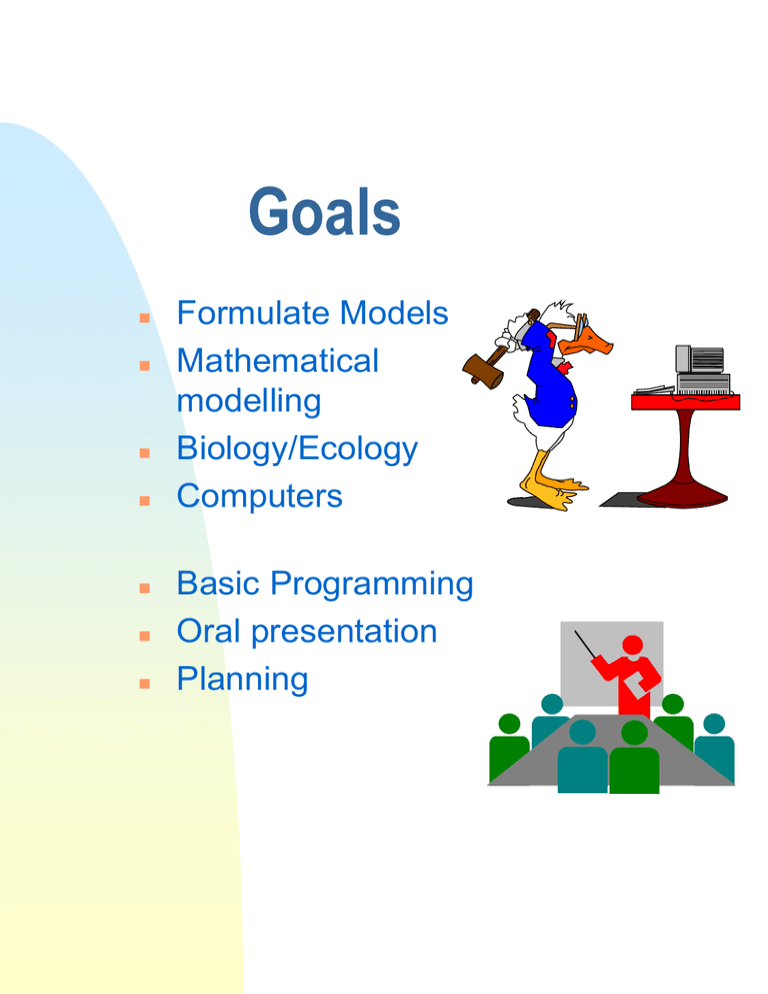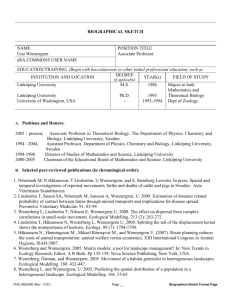Cobweb Diagram
advertisement

Goals Formulate Models Mathematical modelling Biology/Ecology Computers Basic Programming Oral presentation Planning Course Outline Lecture Work on project Oral presenation of project New chapter Mon 18 jan 10:15-12:00 LECT ECO1 Uno Wennergren BL34 Chapter 0-1 Tue 19 jan 13:15-14:00 LECT ECO1 Uno Wennergren E330 Matlab and excel Thu 21 jan 11:15-12:00 SE ECO1 Uno Wennergren Galaxen Available for questions Fri 22 jan 13:15-15:00 SE ECO1 Uno Wennergren BL33 Project presentations Mon 25 jan 15:15-16:30 LECT ECO1 Uno Wennergren E328 Chapter 2 Wed 27 jan 15.15-16:00 SE ECO1 Uno Wennergren Galaxen Available for questions Fri 29 jan 13:15-15:00 SE ECO1 Uno Wennergren BL33 Project presentations Fri 29 jan 15:15-16:30 LECT ECO1 Uno Wennergren BL33 Chapter 3 Thu 4 feb 11.15-12:15 SE ECO1 Uno Wennergren Galaxen Available for questions Fri 5 feb 13:15-15:00 SE ECO1 Uno Wennergren BL33 Project presentations Fri 5 feb 15:15-16:30 LECT ECO1 Uno Wennergren BL33 Chapter 5.1-2 Tue 9 feb 13:15-14:00 SE ECO1 Uno Wennergren Galaxen Available for questions Wed 10 feb 13:15-15:00 SE ECO1 Uno Wennergren BL34 Project presentations 5.1 Wed 10 feb 15:15-16:30 LECT ECO1 Uno Wennergren BL34 Available for questions Fri 12 feb 13:15-15:00 SE ECO1 Uno Wennergren BL31 Project presentations 5.2 Uno Wennergren Theoretical and Computational Biology Organic Farming Threatened Species Spread of disease Animal Welfare 5 PhD students 2 senior researchers Subjects Chapters in the book Basic about models Discrete Processes Deterministic models Stochastic models Continous processes Deterministic models (Stochastic models – excluded) Methods/Tools Graphic methods - Cobweb Spreadsheets - Excel Programing Mathematical Analysis - Matlab Methods/Tools Planning PowerPoint Excel Oral presentations Computer-OH projector Project Plan your time, time schedule Formulate the problem Choose Type of mathematical model What methods and tools to use How to present the results Re-plan Construct the model If possible use critical test Implement the model by excel or matlab Re test the model If possible use critical test Make the code and a ppt presentation tidy – presentable to uno For whom it may concern: prepare for oral presentation Basic about Models A model is a description of reality A mathematical model uses equations to describe reality Two levels of modeling Dn/dt=rn(t) Complex reality I II Simplified Reality Mathematical equations Basic about Models Dn/dt=rn(t) Complex reality I II Simplified Reality Mathematical equations A model usually has a purpose The questions: Is the reality simplified enough to be represented by equations? Is the reality simplified too much and hence the model is no longer a description of reality (not useful)? Discrete Dynamical Systems Discrete processes Events stepwise perennials reproduction (seeds) 1 time/year Continous processes Events all the time Small mammmals reproduction year around Perennials survival? insects reproduction? in temperate climates? Deterministic models Models don’t include variation/chance probability. Parameters are constant All process are the same (within a specific model) and simply a specific chain of events. The result is deterministic: one value Stochastic models include variation/chance probability The result is a set of values Every test generates a new chain of events with its specific result Recurrence equations The equation generates a sequence of numbers The equation calculates a number by using some of the previous number. Example: How many were infected previously determines how many will be infected right now. Which in its turn….. Note: specific step lengths Recurrence equations (linear) General form x(n)=f(x(n-1),x(n-2),….) The order of the equation is set by the number of steps backwards used in the equation x(n)=7x(n-5) is of order 5. How many initial values (numbers) do you need to start the equation to roll? Assume simple growth: x(n+1)=Rx(n) Model type: Difference equaions (number sequence) Of first order: f(x(n-1)) =x(n)-x(n-1) Compare with differential The derivative of f(x): df f ( x h) f ( x ) ,h 0 dx h Box diagram Simple growth x(n)-x(n-1)=rx(n-1) x(n+1)=x(n)(1+r) rx Population x growth bx fecundity Population x i (1-s)x deaths immigration Mathematical analysis Simplest linear recursive equation x(n+1)=Rx(n) has the solution x(n)=Rnx(0) growths exponentially: R>1 decrease exponentially: 0<R<1 Oscillates R<-1 constant or oscillates if R0,1,-1 What about -1<R<0??? Spreadsheets Click and drag Relative addresses =C1*B4 absolute adresses =$C1*B5 =$C$1*B5 rate= Time Population 0 100 1 103 1.03 Matematical analysis Equlibrium points Will the sequence stop at a point? Comes back to itself. Is it stable or unstable? Compare with valley and hilltop. Find and calculate the equlibrium point: Assume x is the equlibrium point test in your equation for example x(n+1)=Rx(n) +a set all x( n) x for big n Then a x Rx a x 1 R Matematical analysis Equlibrium points x(n+1)=Rx(n) gives +a x ( n) x a x Rx a x 1 R Note initial value doesn’t effect whre the equlibrium is The quilibriumpoint is stable if and only if f '(x) 1 Compare with xn=f(xn-1) Cobweb Diagram Graphic method to find the equlibrium points y y=x Stable equlibrium y=f(x) x y=f(x) is a discrete linear model For example x(n+1)=-0.5x(n)+4 can be written as y=-0.5x+4 Cobweb diagram Initial value x* Next step is y=f(x) y y=x y=f(x) x* x Cobweb diagram Next step to take is x=y y y=x y=f(x) x* x Cobweb diagram And then y=f(x) y y=x y=f(x) x* x Cobweb diagram And then this proceeeds, next step is: x=y y y=x y=f(x) x* x Cobweb diagram And y becomes y=f(x) y y=x y=f(x) x* Just proceed and the curve will stepwise move towards the equilibrium if it’s a stable one x Cobweb diagram If it steps away from the equlibrium then it’s an unstable one. y y=f(x) y=x x* x Linear recurrence equation with constant coefficients Look for a solution, compare with x(n)=Rnx(0) A linear combination of x(i) terms, for example m number of terms: a0 x(n) a1 x(n 1) a2 x(n 2) .... .......am1 x(n (m 1)) am x(n m) 0 This is a homogeneous equation since the right hand side is 0. The simplest linear homogenous equation is: ax=0 How to solve it? Calculate the roots to the characteristic equation Matlab funktion r = roots(c) Characteristic equation Assume the solution: x(n) C n after some calculations: a0n a1n 1 a2n 2 ....amn ( m1) am 0 This is the charactersitisc equation, use Matlab funktion r = roots(c) Characteristic equation a0n a1n 1 a2n 2 ....amn ( m1) am 0 Use Matlab funktion r = roots(c) Or just try it yourself without compuer….. for x(n)-2x(n-1)+x(n-2)=0 The charac equation becomes n 1 n2 C 2C C 2 1 2 1 0 n » r=roots([1 -2 -1]) r =2.4142 -0.4142 0 Charactersitic equation Roots to x(n)-2x(n-1)+x(n-2)=0 n 1 C 2C n n2 C 0 2 1 0 2 1 » r=roots([1 -2 -1]) r =2.4142 -0.4142 General solution is x(n)=C12.4142n - C20.4142n Particular solutions, we know that x(0)=0 and x(1)=1 gives that C1+C2=0 which we can use in 1= C12.4142 - C20.4142 C1=1/2, C2=-1/2 Charactersitic equation Roots of x(n)-2x(n-1)+x(n-2)=0 x(n)=C12.4142n - C20.4142n C1=1/2, C2=-1/2 gives particular solution x(n)=1/2(2.4142n - 0.4142n) for big n the first tem dominates (large absolute value) hence: x(n)1/2(2.4142n) Finite limited growth Simple assumptions Simplified reality Whe poulationis zero there is no reduction in individual growth, no competition, i. e. max growth R When population is at a equlibrium it has reached its limits and use the resources, K, such that mean individual growth is zero. Hence: The curve of individual growth in relation to density shall pass the points: (0,R),(K,0) Finite limited growth The curve of individual growth in relation to density shall pass the points: (0,R),(K,0) growth r(x) R r ( x) R R ( x 0) K K population x Linear model: R r ( x) R ( x 0) K Logistic growth R Growth r(x) K population x Linear model: R r ( x) R ( x 0) K Since x(n)-x(n-1)=r(x(n-1))x(n-1) Or even better x(n+1)=x(n)(r(x(n))+1) with r(x) as above we then have x ( n) x( n 1) x( n)( R (1 ) 1) K x ( n) x( n 1) x ( n)( R (1 ) 1) K At right handside there is a quadratic term, x(n),, this is a nonlinear equation! To calculate the equilibrium: Once again assume that there is a equilibrium: Then this have to be true x x x ( R (1 ) 1) K This is a second degree equation with roots: x 0, x K . Deterine the the character of the eq. points:: 2 Rx f ´(x ) R 1 K Test: x 0, x K i f ´(x) 2 Rx f ´(x ) R 1 K x 0, f ´(0) R 1, st able if R 1 1 2 R 0 x K , f ´(K ) 1 R, st able if 1 R 1 0 R 2 If individual maximum (unlimited) growth, R, is larger or qual to 2 there is no stable eq. and chaos and oscillations will appear. Host parasite model Assumptions, simplified reality: The host population N growths according to limited logistic growth N ( n) N (n 1) N (n)( R(1 ) 1) K Add a term that represent how survival decease as the number of parasites, P, increase N ( n) N (n 1) N (n)( R(1 ) 1) CN (n) P(n) K Host parasite model Host population equaion N ( n) N (n 1) N (n)( R(1 ) 1) CN (n) P(n) K The growth of the parasite population also depend on the probability that a host and parasite meet: Assuming proportional to such meetings: P(n 1) QN (n) P(n) Host parasite model System of non linear difference equations N ( n) N (n 1) N (n)( R(1 ) 1) CN (n) P(n) K P(n 1) QN (n) P(n) Look for equlibriums N N N ( R(1 ) 1) CN P K P QNP Solution (N,P): (K,0) (1/Q,R/C(1-1/(QK))) (0,0) Kunskapstaxonomi fritt efter Benjamin Bloom Fakta. Ange, räkna upp fakta, definiera begrepp. Enkel begränsad kunskap. Beskrivning. Innebörden av begrepp och fakta. Tolka, motivera, relatera till varandra. Tillämpning. Vad är innehållet användbart till. Observera, beräkna, kalkylera, formulera, konstruera, lösa givna problem. Analys. Bryta ner innehållet, dela upp, gruppera om, jämföra, generalisera se nya problem. Syntes. Dra slutsatser, formulera regler, se samband också med annan kunskap, resonera, diskutera, skapa nytt. Värdering. Avge omdömen, kritisera, värdera olika kunskap, hypoteser och teorier mot varandra. Komplex, vidsträckt kunskap. Bloom’s Taxanomy A Hierarcical Knowledge Taxonomy Critical Thinking Activity [arranged lowest to highest] 1. Remembering Retrieving, recognizing, and recalling relevant knowledge from long-term memory, eg. find out, learn terms, facts, methods, procedures, concepts 2. Understanding Constructing meaning from oral, written, and graphic messages through interpreting, exemplifying, classifying, summarizing, inferring, comparing, and explaining. Understand uses and implications of terms, facts, methods, procedures, concepts 3. Applying Carrying out or using a procedure through executing, or implementing. Make use of, apply practice theory, solve problems, use information in new situations Relevant Sample Sample Assignments Sample Sources Verbs or Activities Acquire, Define, 1. Define each of these Written records, Distinguish, Draw, terms: encomienda, films, videos, Find, Label, List, conquistador, gaucho models, events, Match, Read, 2. What was the media, diagrams, Record Amistad? books. Compare, 1. Compare an Trends, Demonstrate, invertebrate with a consequences, Differentiate, Fill in, vertebrate. 2. Use a tables, cartoons Find, Group, Outline, set of symbols and Predict, Represent, graphics to draw the Trace water cycle. Convert, 1. Convert the Collection of Demonstrate, following into a real- items, diary, Differentiate world problem: velocity photographs, between, Discover, = dist./time. 2. sculpture, Discuss, Examine, Experiment with illustration Experiment, batteries and bulbs to Prepare, Produce, create circuits. Record 4. Analyzing Breaking material into Classify, Determine, 1. Illustrate examples Graph, survey, constituent parts, determining how Discriminate, Form of two earthquake diagram, chart, the parts relate to one another and generalizations, Put types. 2. Dissect a questionnaire, to an overall structure or purpose into categories, crayfish and examine report through differentiating, organizing, Illustrate, Select, the body parts. and attributing. Take concepts apart, Survey, Take apart, break them down, analyze structure, Transform recognize assumptions and poor logic, evaluate relevancy 5. Evaluating Making judgments Argue, Award, 1. Defend or negate Letters, group with based on criteria and standards Critique, Defend, the statement: "Nature discussion panel, through checking and critiquing. Set Interpret, Judge, takes care of itself." 2. court trial, survey, standards, judge using standards, Measure, Select, Judge the value of self-evaluation, evidence, rubrics, accept or reject on Test, Verify requiring students to value, allusions basis of criteria take earth science. 6. Creating Putting elements Synthesize, Arrange, 1. Create a Article, radio show, together to form a coherent or Blend, Create, demonstration to show video, puppet functional whole; reorganizing Deduce, Devise, various chemical show, inventions, elements into a new pattern or Organize, Plan, properties. 2. Devise a poetry, short story structure through generating, Present, Rearrange, method to teach others planning, or producing. Put things Rewrite about magnetism. togther; bring together various parts; write theme, present speech, plan experiment, put information together in a new & creative way










